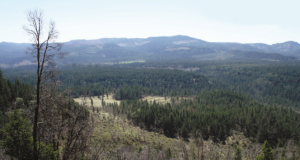TOUGH MOUNTAIN TO CLIMB
THE CHALLENGE OF QUAIL HUNTING
By Scott Haugen
Rounding a corner in the logging road, I brought my mountain bike to a slow halt. Moving forward on foot, I confirmed that what I’d seen from the bike was, indeed, the head of a mountain quail.
Inching toward the bird, one head materialized into two – then three. The birds grew nervous and headed to timber’s edge, so I quickly followed. Just as I got within shotgun range, the small covey flushed. I dropped the first bird, cleanly missed the second, and they were gone before I could get a third round off.

I’d already taken a mountain quail earlier in the morning, as well as a brace of valley quail. The day was off to a good start.
In their mountainous home of Northern California, both mountain and valley quail are survivors. From clover to stray berries to willow buds, insects and more, both quail species feed on just about anything they can find. This time of year, grasses and clovers are a delicacy, but something that’s more prevalent as winter progresses.
Of the two quail, mountain quail are the most challenging to hunt. Because they live in brushy, often steep terrain, and the fact they are more apt to run from danger than take wing, hunting them can be a challenge. In fact, many upland bird hunters rate mountain quail the toughest of all North American quail to pursue.
But one thing both birds have in common is their need for gravel in the gizzard to help grind food, and where many birds gather grit is along the edges of logging roads. This time of year, locate some fresh, green grass and clover growing near a logging road, and surrounded by forest or brushy thickets, and the conditions are prime for finding both valley and mountain quail.
Power line right-of-ways are also great quail habitats, and valley quail often frequent them year-round. Mountain quail will also migrate to these habitats late in the year. These areas offer a variety of grass seeds and insects, and cover is usually good, meaning upland birds love it.
Hunting quail in these habitats means hitting logging roads, either by truck, mountain bike or on foot. For the best results, focus on spur roads running through logged areas with a mix of reprod or brush, places that have had little or no traffic, with grass growing at least a couple inches tall.
Secluded roads are prime locations early in the morning and late in the evening, a time when most upland birds gather grit. While both quail actively gather grit in the early morning hours and later in the day, they might be found feeding any time of day, especially on cool, overcast days.
As winter conditions prevail at higher elevations, quail will often tuck themselves into the safety of thicker cover. Also, search willow thickets and river bottoms at lower elevations, where quail often congregate. If the weather is bad in the high country, mountain quail can drop a surprising distance in elevation.
Mountain quail lead a less social lifestyle than valley quail. While valley quail join big flocks with winter’s onset, mountain quail tend to remain in single family units. Also, once mountain quail find a place they like, they’ll remain there for some time, so if it’s a big
family flock you may have only taken one bird from, go back with the idea of securing more in the near future.

Valley quail are more social than mountain quail and can be found from lower elevations to high-ranging peaks in the Coast and Cascade ranges, throughout the northern part of the state. Late in the year the two species’ ranges are more likely to overlap, making it prime time for a prized double.
Hunting for mountain and valley quail, the blue bombers of the West, is exciting and challenging. Rays of sunlight slicing through the forest, the chill of winter in the air and the distinctive silhouettes of these special birds, all combine to make this a memorable hunt. For a dose of quail – and some very tasty meat – lace up the hiking boots, put in the time and see what this type of hunting is all about. CS
Editor’s note: Scott Haugen is the host of Trijicon’s The Hunt on the Sportsman Channel; in 2015, he will cohost Alaska Outdoors Television on the Outdoor Channel. Go to scotthaugen.com for more


